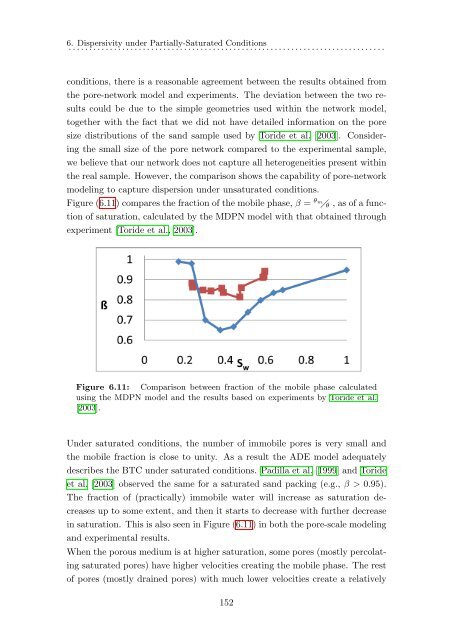download pdf version of PhD book - Universiteit Utrecht
download pdf version of PhD book - Universiteit Utrecht
download pdf version of PhD book - Universiteit Utrecht
Create successful ePaper yourself
Turn your PDF publications into a flip-book with our unique Google optimized e-Paper software.
6. Dispersivity under Partially-Saturated Conditions<br />
. . . . . . . . . . . . . . . . . . . . . . . . . . . . . . . . . . . . . . . . . . . . . . . . . . . . . . . . . . . . . . . . . . . . . . . . . . . . .<br />
conditions, there is a reasonable agreement between the results obtained from<br />
the pore-network model and experiments. The deviation between the two results<br />
could be due to the simple geometries used within the network model,<br />
together with the fact that we did not have detailed information on the pore<br />
size distributions <strong>of</strong> the sand sample used by Toride et al. [2003]. Considering<br />
the small size <strong>of</strong> the pore network compared to the experimental sample,<br />
we believe that our network does not capture all heterogeneities present within<br />
the real sample. However, the comparison shows the capability <strong>of</strong> pore-network<br />
modeling to capture dispersion under unsaturated conditions.<br />
Figure (6.11) compares the fraction <strong>of</strong> the mobile phase, β = θm θ , as <strong>of</strong> a function<br />
<strong>of</strong> saturation, calculated by the MDPN model with that obtained through<br />
experiment [Toride et al., 2003].<br />
Figure 6.11: Comparison between fraction <strong>of</strong> the mobile phase calculated<br />
using the MDPN model and the results based on experiments by Toride et al.<br />
[2003].<br />
Under saturated conditions, the number <strong>of</strong> immobile pores is very small and<br />
the mobile fraction is close to unity. As a result the ADE model adequately<br />
describes the BTC under saturated conditions. Padilla et al. [1999] and Toride<br />
et al. [2003] observed the same for a saturated sand packing (e.g., β > 0.95).<br />
The fraction <strong>of</strong> (practically) immobile water will increase as saturation decreases<br />
up to some extent, and then it starts to decrease with further decrease<br />
in saturation. This is also seen in Figure (6.11) in both the pore-scale modeling<br />
and experimental results.<br />
When the porous medium is at higher saturation, some pores (mostly percolating<br />
saturated pores) have higher velocities creating the mobile phase. The rest<br />
<strong>of</strong> pores (mostly drained pores) with much lower velocities create a relatively<br />
152

















